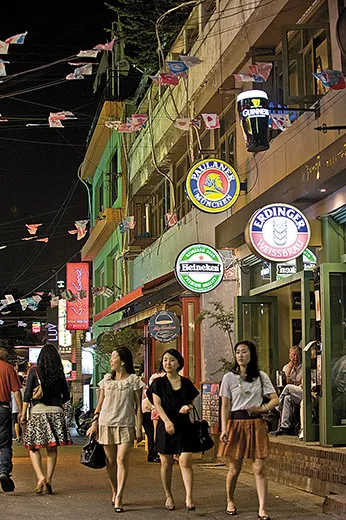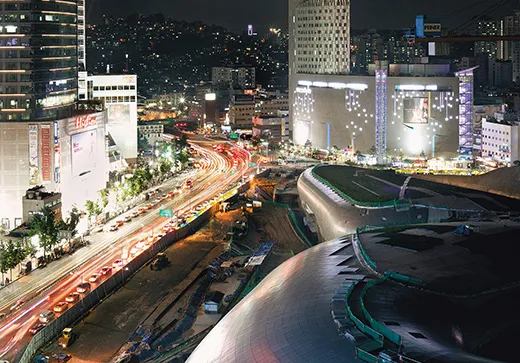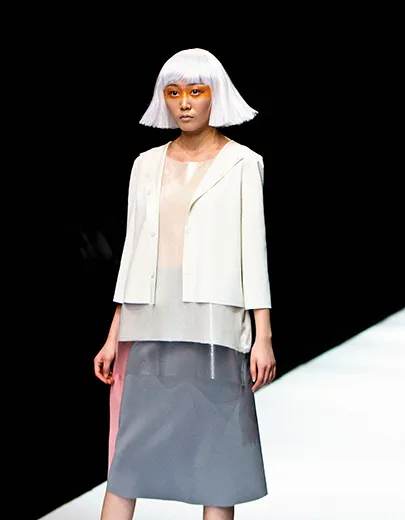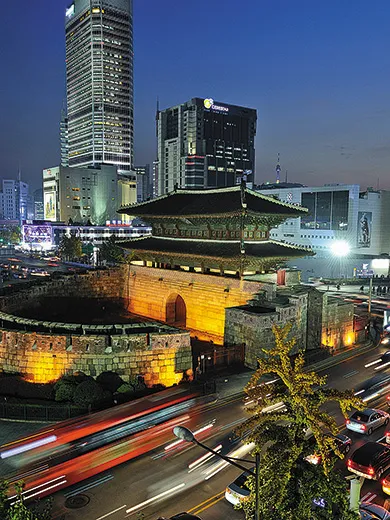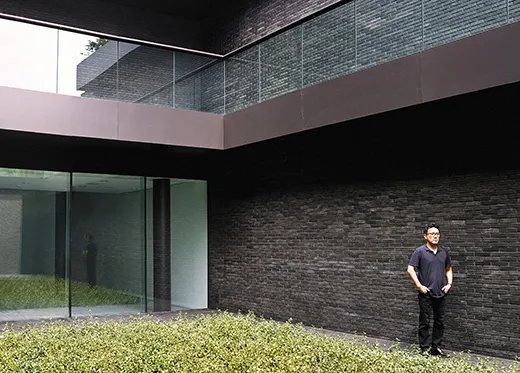Welcome to Seoul, the City of the Future
The once poor South Korean city has bloomed into a cultural capital with high-profile architecture, top museums and an influential arts scene
/https://tf-cmsv2-smithsonianmag-media.s3.amazonaws.com/filer/Seoul-Dongdaemun-Design-Plaza-631.jpg)
I’m being chauffeured through a parking garage above Seoul’s main train station with Minsuk Cho, who heads one of the city’s most innovative architectural practices, Mass Studies. We got into a car on the first floor, supposedly to whisk us away to a party, but as we wind up and around the spiral ramp of the dimly lit structure, we become more and more confused about exactly where the driver is taking us. Atop the garage, which didn’t seem glamorous inside or out, we are met by the blinding explosions of dozens of paparazzi flashes. The photographers aren’t stalking us, of course, but the Korean pop starlets who stride down the red carpet at the entrance to this one-night Seoul art/fashion event hosted by New York’s New Museum and Calvin Klein.
After grabbing two glasses of champagne we position ourselves so we can look across the street at the Korean-made, American-curated centerpiece of the event: a striking video artwork playing on a 20-story-high LED display normally used for advertisements, one of the largest of its kind. Cho tells me that the artists had to observe some very serious restrictions: “That display is so huge that if the video moves too fast, drivers stare at it, mesmerized, and they crash,” he says.
As we wander the white-tented party, moving from a room filled with buff and beautiful international underwear models to a congregation of American actors and then Korean artists, Cho tells me he can’t believe the changes he’s witnessing in his hometown. “When I left Seoul to study in New York 20 years ago, an event like this would have been inconceivable,” he says. “Forget about the international art world and the celebrities—just finding any Koreans dressed as well as the people at this party would have been impossible back then. Things have really changed.”
In only a few decades, this capital has transformed itself from an impoverished city decimated by the Korean War to one of the most prosperous and high-tech places in the world. In the past decade there’s also been an explosion of international interest in Korean popular culture, especially catchy K-pop music, soapy TV dramas and edgy cinema, making the most famous Korean singers, stars and directors household names everywhere from Tokyo to Beijing. Koreans even have a name for this blossoming of foreign interest in their homegrown pop culture: hallyu, which means Korean wave. Korea has long been dwarfed by China and Japan, far more populous nations that have colonized the Korean Peninsula, and so this recent cultural hegemony has given Seoul residents a newfound confidence, even exuberance, in their city.
Compared with the capitals of Japan and China, Seoul is, at first, a harder place to love, since much of it was built out of extreme necessity—made to be functional, not beautiful. The postwar period saw a huge influx of people from the countryside; the city now contains ten million people, 20 percent of the population of all South Korea. From 1960 to 1990 Seoul gained roughly 300,000 new residents per year. It needed to worry more about how these newcomers would survive than how aesthetically pleasing their environment would be.
This transformation from third-world poverty to a booming export-oriented economy, coupled with extreme wealth, massive population growth and expanded global cultural power, means that Seoul isn’t just a phenomenon in its own right; it’s also a model for cities in China, India and Brazil trying to cope with many of the same problems Seoul faced. (South Korea only eclipsed North Korea economically in the late 1970s.) Myounggu Kang, an urban planner I spoke with at Seoul University, now hopes to pass on what the country learned to the next generation of planners in rapidly expanding cities in Africa, Asia, South America and the Middle East. “The now forgotten urban planners from decades ago should be national heroes,” Kang tells me. “They helped lead this city from ruins to riches. We hope the world can learn from them.”
Nowadays, with Korea’s prosperity cemented, there’s been an important shift in Seoul’s values; the city has moved from pure functionalism—and dire necessity—to form, livability and aesthetics. Seoul was named World Design Capital in 2010 by a prominent alliance of industrial designers and has become a mecca for superstar architects seeking marquee projects. This was especially true under its last mayor, Oh Se-hoon, who emphasized up-grading the look of the city, sometimes even, according to his critics, at the expense of health care and infrastructure. What makes Seoul right now such a dynamic and surprising locale is that it’s a place in flux on so many levels: The new architectural aspirations of the city are meeting—and sometimes clashing with—the bland uniformity of its past. Seoul residents are some of the earliest adopters of new technology in the world, especially cellphones and mobile computing devices, and their immediate access to the most up-to-date information means that the city’s hottest neighborhoods and sleepiest sections can change overnight.
Seoul Never Sleeps
This contrast between the old and new Seoul is felt most strongly in Dongdaemun, a commercial neighborhood in the northeast of the city that boasts a wholesale market, much of the city’s clothing and design industry, a newly erected history park and the soon-to-open Dongdaemun Design Plaza, a project of Iraqi-British architect Zaha Hadid. I venture into the design plaza construction site with JB Park, the senior manager in charge of construction at DDP, and Eddie Can, Hadid’s man on the ground. It is high noon and quiet—only a few people wander aimlessly up and down the blocks, and there’s none of the energy found a couple of miles west in Myeongdong, a teenage shopping haven filled with young women clamoring for the latest eyewear, fashion and makeup. Park leads me into the belly of the beast, an enormous, curved structure that sits on what was once a sports stadium and now stands out like an alien spaceship.
“The old stadium was erected under Japanese occupation,” says Park. “And so it always had that association.” The original plan was to raze the stadium, expunging its ghosts, and create a cultural center for the city’s fashion and design industry. But when builders broke ground, they discovered that a whole section of Seoul’s ancient wall had been buried below the stadium. So instead, the city created a park to memorialize the archaeological remains, shrinking the footprint of the original Hadid project. After we exit the construction site, I have a coffee with Eddie Can. “This area is dead now,” he tells me. “You have to come back here at 2 a.m. That’s when Dongdaemun comes alive.”
A block north of the design plaza site I find another rediscovered part of the city’s landscape: the Cheonggyecheon River, long buried under roadways and buildings, and unearthed in 2005 to create a recreational area slicing two miles through the center of town. Sidewalks and the river lie nearly 20 feet below ground level in a landscaped concrete canyon. This new Cheonggyecheon is a man-made sanctuary of flowing water teeming with fish and plants, insulated from the noise, heat and chaos above. This river is, to me, an even more radical, transformative and spectacular project than the city’s many brand-new, larger-scale structures.
I follow Can’s instructions and return that evening to find what must be one of the world’s most intense night markets, consisting not just of thousands of street vendors, but also of multiple high-rise shopping malls, filled with fashions of all kinds. Selling starts at midnight, when the vendors roll in to pitch their tents, and lasts until 5 or 6 a.m.
All of this points to an interesting dimension of Seoul life that doesn’t exist just in Dongdaemun: What most distinguishes this city is not its grand high-rises, its elaborate transportation system or the careful urban strategizing of its city planners, but the intense 24-hour activity that no one planned: the all-night shopping malls of Dongdaemun; the ornate, multistory jjimjilbang spas with dozens of different pools and saunas that pump all day and night; and the fried-chicken joints packed until 5 every morning. For this native New Yorker, a night out in Seoul made me think, forget NYC, Seoul is the city that never sleeps.
When I ask Seoul residents why this unique culture has developed here, I get a variety of responses: People work so hard that when they get home they just want to play, get drunk, decompress. Apartments are so small that you have to go out to enjoy yourself. Koreans are by nature communal and therefore most comfortable in a large group of friends. None of these answers completely satisfies me. But as I catch a cab home from Dongdaemun, I realize that as important as it is for urban planners elsewhere to learn from Seoul, what they cannot do is plan for the unplanned—the utterly human things that set a city apart. For some inexplicable reason what’s emerged organically in Seoul is that its residents are ready to live by night.
Home again
The last time I visited the Seoul neighborhood of Itaewon it was to tell a tragic tale: I was producing a TV documentary about the murder of a young American student named Jamie Penich who’d been killed in a seedy motel in Itaewon where she’d been staying with friends who were studying abroad with her in Korea’s second-largest city, Pusan. Since just after the war, Itaewon had been notorious as the playground of American G.I.’s: Its most prominent landmark was a slope called Hooker Hill, a steep set of alleys that house bars where scantily clad Korean bar girls call out in heavily accented English after foreign men strolling by. Another notable feature of Itaewon during my last visit was its immigrant population, mostly Africans, assumed in local popular lore to be undocumented and engaging in all kinds of questionable activities. That was six years ago.
On this trip to Seoul, when I reach out to a Korean film director, he suggested we meet at a nighttime art performance in the back alleys of Itaewon. I find the neighborhood transformed. Somehow this once-sordid place has become one of the hippest addresses in Seoul, housing cafés and cocktail bars, architecture and design firms, not to mention a top private museum: Leeum, Samsung Museum of Art. The audience at the art performance is a combination of foreigners and locals, many of whom have been educated abroad. Another film director I meet there had recently returned from studying in the United States. “This neighborhood is an easier place to adjust to after being abroad,” he tells me. “There are foreign bars and restaurants, foreign people, and that makes it an attractive place to live for returnees like me.”
Minsuk Cho, the architect, recently designed a new building near the Leeum museum complex in Itaewon, which he also calls home. “I’ve worked all over the world,” says Cho. “But there’s something different, something special, about designing a building just down the street from where you live and work. You know the people. You know the neighborhood. And it better be good, because you’re going to have to keep looking at it for as long as you live [there].”
This rapid transformation of Itaewon also makes me ponder how quickly things change in Seoul. “We have one of the most mobile urban populations in the world,” Myounggu Kang, the Seoul University planner, told me. “About 25 percent of the city’s population seems to relocate each year. And clearly this turnover has a tremendous affect on how rapidly things can change.” He suspects that education is behind this extreme mobility. “Many of our best schools are located in the Gangnam area, south of the river,” he says. “And so it may be that parents are moving there, despite higher prices, when their children are at critical points in their education, then moving back to more affordable areas when they graduate.”
After decades of living abroad, Korean expats are returning to Seoul. These returnees are, of course, accelerating the development of a cosmopolitan Seoul, bringing back not just foreign cultural influences, but also examples of Korean culture intermingling abroad: Vatos, a new Itaewon restaurant, serves the kind of Korean tacos that the Kogi truck pioneered on the streets of Los Angeles.
During my visit, Seoul residents waited in long lines at the Leeum museum to see one of their own, Do Ho Suh, a Korean-born artist who splits his time between Seoul and New York and whose work explores migration, permanence and what it means to be Korean. Inside the vast exhibition space I see three-dimensional exteriors and interiors of traditional Korean homes, constructed in elaborate, intricate detail, but built entirely out of colored silks that hang from the ceiling. The fact that Suh’s work, while cerebral and abstract, had struck a chord with so many Seoul residents confirmed what I’d thought about the power and potential of the many Koreans now returning home. It was appropriate that this point was being communicated in Itaewon, a place with a strange and sordid past that was now home to many Korean artists, designers and architects who had made the same journey Suh had to America and back.
Looking North
At the suggestion of Grace Meng, a Korean food blogger, I venture into a famous Seoul noodle shop called Pyongyang Myeong Ok. The specialty of the house, as the name of the restaurant suggests, is a North Korean dish that is one of the most popular foods in the South: Naeng-myun, buckwheat noodles served in a chilled broth. The noodles are freshly made, spun by hand and perfectly chewy. The broth is bracing and vinegary. It’s a perfect, simple summer food. But as I slurp down the last noodles, I think how strange it is for there even to be such a thing as a North Korean specialty food, given the past couple of decades of squalor and starvation that have characterized life in the Democratic People’s Republic of Korea. The noodles offer a glimpse of what things must have been like before the war, when its capital, Pyongyang, was famous not just for its spicy noodles and hearty meat dumplings but also for its bawdy nightlife. Today Tokyo, Shanghai and Hong Kong are the obvious nearby cities to compare Seoul with: They are wealthy, high-tech and connected to the world and its business. A much less obvious comparison is with Pyongyang. The city is poor and primitive and, in that sense, a kind of frightening inverse image reflecting back at Seoul. The cities are just 120 miles apart, but between them lies the demilitarized zone, the most heavily guarded frontier in the world: The south side of the border houses not just the South Korean Army, but also tens of thousands of U.S. troops. The north side is home to what is probably the largest artillery assortment in the world, about 11,000 pieces in all, most aimed at the population of Seoul, which sits only 30 miles from the DMZ.
In 2010, on a visit to Pyongyang and the North Korean side of the DMZ (Americans are actually now allowed to visit North Korea without a problem), I was immediately struck by how people who speak the same language and once lived as one are about as different as any two groups can be. Yet still, because of ties of blood, culture and history, they exist in a strange, sometimes even symbiotic relationship. The obvious threats of the North are violent provocation, war and nuclear attack. Less obvious is what would happen if the North fell apart and the South were faced not with a military foe, but the prospect of caring for 25 million people, many of them malnourished from years of famine, unschooled in the ways of the modern world and deeply traumatized after living under one of the most brutal dictatorships in history.
North Korea is not only a land of farce, drama and tragedy—as its recent boasts, blastoffs and misfires have demonstrated—but also probably the last truly unknowable place on earth. For residents of Seoul, who may even have relatives in the North that they haven’t seen for 60 years, worries and tension persist. And so, just as there was once a whole industry of Kremlin and China watchers—who sought to research, understand and sometimes even imagine what life was like on the other side of mostly uncrossable borders—so too is there in South Korea a phalanx of North Korea watchers, whose job is to try to decipher what life is like in that most inscrutable place.
On my trip to North Korea, I got a glimpse of just how difficult it was to understand the country, even from the inside. My visit, during which I saw only and exactly what my tour guide allowed, actually made me even more curious. It was the only country I’d ever visited where reading books about the place seemed to tell me more than actually setting foot there. And so, in Seoul, I went in search of experts to try to understand how they had been able to decipher life across the border. I met a professor at an educational institution called the University of North Korean Studies, incongruously situated in one of Seoul’s most beautiful and well-preserved precincts, an area of historic houses, lush gardens and gentle hills. Woo Young Lee welcomes me into his office before a class and I ask about the state of North Korean studies. “Things have changed a lot in the last decade,” Lee tells me. “After the famine [in the North in the mid-1990s], the border with China became a lot more porous. South Korean TV dramas and K-pop music are now available all over the North—illicitly, of course. And we are getting a lot more information about what life is like over there.”
What really fascinates me in talking to Lee is the pathos of his job: Lee spends his life trying to understand the workings of a place he can only rarely visit. And even on those trips, his access to information is severely limited: “I try to talk to all the people in the hotel: the barber, the bartender, the waiter, and see what they have to say about what’s happening now in Pyongyang,” he says. “I know that they aren’t representative of the average person in the country, but I still learn something. You do what you can to try to know the place. But ultimately it’s only a partial vision of the whole.” Which would be, perhaps, more acceptable if the place you were trying to understand stood at the other end of the earth. But when it is staring at you across the border, armed to the teeth, these epistemological problems become much more than that—they mean that you can’t really know what’s happening in the one place that has the power to upend your city’s future forever.
City of the Future
What if the people who erected the thousands of ugly but functional apartment buildings that dot Seoul, who laid down city streets sometimes eight lanes wide, who built this place, as Myounggu Kang told me, out of necessity and not for beauty, could start again and build an entire Korean city from scratch? What would it look like? Just seven miles from Seoul’s international airport, and adjacent to the city of Incheon, is Songdo, an entirely new city built on top of land reclaimed from tidal flats. It may provide an answer. No one lived in Songdo before—the land was covered by the sea. It wasn’t thrown together to accommodate a housing crisis. Located between China and Japan and a three-hour flight from eight of the world’s top urban centers, it was designed as a major business hub.
From central Seoul I take an express train to the airport, then a taxi across a very long causeway to Songdo. Before I arrive I can see the high-rises looming over the waterfront. Scott Summers, who works for Gale International, the U.S. company behind a large part of the Songdo project, takes me up to the 52nd floor of a residential building to look out on what his company has created.
As I gaze at the neat rows of high-rise buildings punctuated by small and large parks and bisected by a canal, I realize that this place is the opposite of Seoul. It has ample room for residents to stroll the streets, play in parks and cruise the tranquil canals. “We drew our inspiration from cities around the world,” Summers tells me. “Pocket parks from Savannah, an arts center modeled on what Sydney’s opera house has done for that city, a huge swath of parkland based on New York’s Central Park.” The global financial crisis has made the Songdo project much more challenging than when it was first conceived. As we return to ground level and drive through the streets, it’s hard to assess the project’s success because only a small number of residents and businesses have moved in.
Songdo is one of the most intensely planned places on earth. There is no history to contend with. There is only the future. I think about what Seoul residents have made of their city and wonder what Songdo will look like when those same human forces do their work here. If rapid and radical changes in Seoul are any indication, Songdo residents will make something distinctive, living—and entirely unanticipated—out of the raw materials this new city is offering them.
Planning Your Next Trip?
Explore great travel deals
Smithsonian magazine participates in affiliate link advertising programs. If you purchase an item through these links, we receive a commission.
